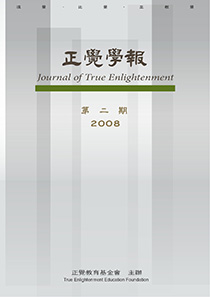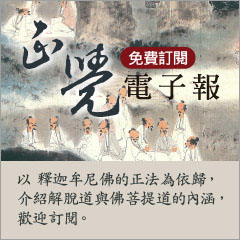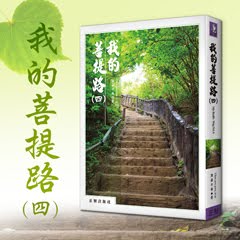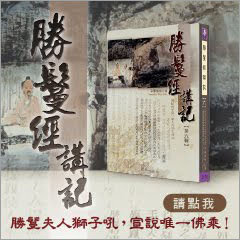Journal of True Enlightenment ─ Issue 2
【作者】正覺學報編輯部
【出版日期】2008年12月
【書號】978-986-83966-2-3
【開本】188頁
【定價】300元台幣/ 輯
學報宗旨
編輯序言
學報宗旨
正覺學報的宗旨,在於弘揚釋迦牟尼佛實證第八識如來藏而成就佛道的佛法義學,秉持學術界客觀求真的科學精神,以合乎三量--至教量、現量、比量--的辯證方法,公平客觀的引證態度,以及真修實證的立場,引導佛學界回歸以實證為目標的佛法義學。
Mission Statement
The mission of the Journal of True Enlightenment is to spread Buddha Sakyamuni's doctrine of attaining Buddhahood through the personal realization of the eighth consciousness, Tathagatagarbha, and to guide the Buddhist academia back to the correct understanding of Buddhist sutras based on the scientific spirit of objectively pursuing the truth, the methodology of the three-ways-of- knowing—knowing by ultimate teachings, personal experience and logical inference, the fair attitude of citation, and the standpoint of both real practice and personal realization.
在探求真理的路上,古今中外之賢聖都是依據事實的觀察而實證,並透過嚴密的論證來演述給眾生了知。本學報亦本於此佛法義學求真求實的精神而創刊,並以現代學術論文的方式來發揚佛法正理,揭示現代佛學學術界眾多學者一向都忽略的實證精神。除此之外,本學報中所採用的論文皆是依據論藏三量──至教量、現量、比量──的嚴密方法闡釋佛法中深妙義理,而此三量正是引自西方神學體系的現代佛學學術界所缺乏的學術標準。由於近代佛學學術界普遍缺乏論議的標準,往往猶如天馬行空一般各自發揮,使得佛學學術論文脫離了追求真理的目標,這是整體佛教教界與學術界的極大損失。因為大量的人力、時間與資源的投入,所獲得的結論卻常常產生錯誤,無助於真理的追求、解脫的實證與法界光明的增上,對於世人當然是極大的損失。為了避免這種長期的資源浪費與損失,而且有助於學術界追求真理,以及對傳統佛教一向所採用富有實證精神的論藏三量標準,都能精準地修正方向及實際理解,本學報要求所有論文作者都以此標準來造論,確實值得佛教界與學術界的重視。
由於以論藏三量的標準所撰寫的論文,才能正確地處理佛學與哲學所面對的所有命題並獲致可靠有效的結論,而此結論將具有實證與實踐的意義,並非文字訓詁式的研究與空談。因此,以論藏三量為標準的學術論文,可以預見地將會是未來東西方哲學學術界所必然採用的標準與主流。由於現代學術界的訓練中缺乏論藏三量的元素,使得要以論藏三量的嚴謹標準來撰寫學術論文,成為高難度的學術創作,也是現代佛學學術界亟待建立的學術能力。在這樣的環境條件與標準下,本期學報採用三篇論文:
- 《阿含經》之聖法印略探──兼略論不生不滅法史觀(蔡禮政)
- 以《阿含經》略論道德的根源──並略評釋昭慧《佛教後設倫理學》(陳介源、蔡禮政)
- 阿賴耶識的內涵與外延──評陳一標〈有關阿賴耶識語義的變遷〉(游冥鴻)
蔡禮政著作的〈《阿含經》之聖法印略探─兼略論不生不滅法史觀〉,乃依據富有實證精神之三量標準,探討《阿含經》中釋迦牟尼佛於經中所舉示佛法的準繩──聖法印──的意涵,以作為佛學中判斷各種學說是非對錯的標準。該文探討釋迦牟尼佛所證悟「實相」的內涵與法印之間的關係,進而深入探討佛教核心教義中「法」有「生滅法」(其異名有:五蘊法、緣起法、緣生法或一切法等等)及「不生不滅法」(其異名有:涅槃、空性、如來藏等等)兩大分類的要旨。該文申論生滅法與不生不滅法是法界必然存在的二種法,二者之間有嚴謹的分類與邏輯關係。如果混淆二種法之間的分類關係而認為彼此可以轉換,或者主張只有其中的一種存在,必然會產生嚴重的邏輯錯誤。因而此種分類與關係,可以作為論斷各式學說主張的準繩,也是構成法印的基本要素。該文將法印的結構分為「根本法印」與「對治法印」以對應不生不滅法與生滅法;並且認為小乘的三法印中,涅槃寂靜法印是「根本法印」,即是大乘不生不滅的一實相印而含攝其他生滅的「對治法印」。此項法印的見解在學術界確屬創見。
此外,該文辨析及歸納出「釋印順所闡述的佛教史為『生滅法史觀』,並不符合法印的準繩」,因此提出「不生不滅法史觀」的獨到見解。該文中「法印與史觀」的部分,辨析釋印順將印度佛教史切割成三個時期而對應小乘的三法印,有嚴重的邏輯錯誤;並證明「不生不滅法史觀」才是符合佛教教理的正確史觀,並且是以「不生不滅法」作為佛教的核心教義──不論是大乘教或小乘教。此亦是極富學術創見並且符合論藏三量的標準。
陳介源、蔡禮政合著的〈以《阿含經》略論道德的根源──並略評釋昭慧《佛教後設倫理學》〉,該文以《阿含經》的義理探討西方哲學二千餘年來,到現代物質文明發展困境下,人類所一直關懷的倫理學的核心命題──道德的根源。該文認為探討倫理學命題的同時,應該先建立穩固而無法破壞的價值體系。現代倫理學繼承二千年來西方哲學對於善、正義、道德受體……等道德用語無法永遠明確定義的困境,一直無法對於人類的道德實踐有重要的指導意義,就是因為缺乏穩固一致的價值體系。該文認為十法界是佛教所主張永恆且穩固的價值體系,並且以《阿含經》證明:入胎識如來藏是出生與住持十法界的根源,所以也是價值的根源。由於如來藏的真實存在而可以實證,因此使得十法界的價值體系具有實證與實踐的意義。這是現代佛教界與學術界的重要創見。
在十法界的價值體系中,六凡業道是所有有情必須面對的業道抉擇,四聖法道則是所有有情厭惡業道輪迴後,所必須面對的法道抉擇。人類每一世的每一事件都在面對業道與法道的抉擇,如果沒有正確的價值觀與抉擇的智慧,就無法對倫理學的命題進行探討與定義。該文認為佛教的義理是主張具有實證意義的「自由意志的抉擇智慧」,是在自由意志下以實證的智慧進行實踐道德的抉擇。該文認為,康德主張基督宗教是理性宗教,卻是以不能實證與驗證的公設為前提,本質上並不是理性宗教。佛教是以實證三種事實:1、自由意志的抉擇,2、如來藏永恆存在,3、法界實相的智慧,在這三者都可以貫徹及親證的前提下,使得佛教成為真正的理性宗教,因此亦使得自由意志的抉擇智慧具有指導道德實踐的意義。
此外,該文並因釋昭慧《佛教後設倫理學》一書中對於現代倫理學的許多重要命題有所探討,因此特選該書作為評論的基礎。佛教雖然是一個古老的宗教,對於現代倫理學的種種重要命題與道德用語的定義,卻仍然能夠跨越時間與空間的限制,對於現在物質文明發展下的困境提供發人深醒的智慧,以作為現代人類實踐道德的判斷準則,因為佛教的義理是宇宙中的真相而不可能被改變。因此,該文認為佛教本質是科學、先進與文明的,同時亦顯示佛教一向超越世俗的自由、民主、人權等普世價值,而追求出世間絕對自由──成佛──的最究竟普世價值。由於該文對於倫理學的架構有完整的論述,對於善的定義與道德的根源,亦有獨到的創見並切合《阿含經》的義理,且極富深度、廣度與高度。該文對於倫理學的研究方法論亦提出極為精闢的主張與創見,因此內容極為精彩豐富,是難得一見的佳作。
游冥鴻所著〈阿賴耶識的內涵與外延──評陳一標〈有關阿賴耶識語義的變遷〉〉,以語意學中內涵與外延的術語,來說明法界實相心──阿賴耶識、第八識、藏識、異熟識、阿陀那識、心、所知依,並申論阿賴耶識的存在乃是一種客觀的事實,所以祂有具體的內涵與外延,也能讓人觀察到祂的存在,因此阿賴耶識乃是客觀的存在而有實證的意義。該文以學者陳一標的論文為例,提出大部分的西方和日本學者,將佛教的義理當做思想來研究,這其實是違背佛教經教的基本主張,因為佛教的經教中處處皆留存著要求實證的文字證據。這些學者因為偏見與方法上的錯誤,所得的結論即成為文字訓詁的遊戲而不具有效性。
該文以《阿含經》的經文來探討阿賴耶識內涵,並舉證《成唯識論》、《攝大乘論》、《解深密經》所說內涵,作為實證阿賴耶識的外延的重要參考。例如,從阿賴耶識是無始以來的存在,是不待他緣、本然的存在,是諸法的根本因;以許多面向來說明永恆存在的阿賴耶識,其存在條件與方式與其他諸法的存在條件是截然不同的。此外,阿賴耶識隱藏於肉體內,維持眾生的壽命,是眾生所貪愛的對象,並且被眾生內執為我,因此阿賴耶識是具有具體內涵的心體。然而,阿賴耶識一詞在語意學中,其實是具有「能藏、所藏與執藏」三種意義,使得不能實證阿賴耶識的古今中外學者,對於阿賴耶識與種子之間的關係是一抑異?只能想像與猜測而產生種種誤解。該文對於阿賴耶識的內涵與外延的詮釋,有極精闢的創見;並指出阿賴耶識的外延,不是語言文字所能夠圓滿表述的,因為祂正是語言文字所指涉的真實事物,是實證的標的,只能以實證的方法來認識。阿賴耶識是唯有大乘見道以上的菩薩才能夠實證,並且真正了知阿賴耶識的內涵與外延而能夠有詮釋的能力;故非尚未親證的阿羅漢所知,更非阿羅漢所能詮釋。因此,該文亦是一篇精闢而有創見的佳作。
佛法義學的本質是以實證法界中事實真相的智慧,作為實踐道德的依據,使得論文作者、讀者、被評論者,皆可以因為追求真理增進法界光明而獲得利益。以上三篇論文皆係採用實證精神的三量標準所撰寫的論文,由於論證嚴謹,所以其結論皆具備有效性,可以作為學術界的重要參考,都是難得一見的優秀作品。
Briefing
In the pursuit of truth, the sages and saints since ancient times, around the world, all have their actual realization based on the observation of facts, and expound it to sentient beings through rigorous demonstrations. Based on this truth-seeking spirit of Buddhist practical theory, this Journal is published to propagate the correct theory of Buddha-dharma with modern academic papers, and to demonstrate the positivist spirit that is often neglected by many scholars in modern Buddhist academia. In addition to that, the papers of this Journal all explain the profound Buddhist doctrines based on the rigorous methodology according to the principle of three-valid-cognition-ways for Buddhist treatises, namely valid cognition by ultimate teachings, direct perception and logical inference. The principle of three-valid-cognition-ways is exactly the academic standard that the modern Buddhist academia, which follows the system of Western theology, lacks. Owing to the general lack of argumentation standard in modern Buddhist academia, the researchers often express their views individually in an unrestrained way, which makes the Buddhist academic papers away from the goal of seeking truth; this is a great loss to the whole Buddhist world and academia. Because a large amount of human power, time and resources has been used, and yet the wrong conclusions have often been drawn, without any help in the pursuit of truth, the actual realization of liberation and the greater glory of dharma-realm; it is certainly a great loss to the people of the world. To avoid this long-term waste and loss of resources, and also to help the academia pursue the truth, accurately correct the direction and actually understand the standard of three-valid-cognition-ways for Buddhist treatises (which is full of positivist spirit and is always followed in traditional Buddhism), this Journal requests all the authors to write papers based on this standard and it really deserves special attention from the Buddhist world and academia.
Only those papers that are based on the standard of three-valid-cognition-ways for Buddhist treatises can correctly deal with all the propositions about Buddhism and philosophy and reach reliable valid conclusions; these conclusions will have the significance of actual realization and practice, but not just researches and empty talks like explanatory notes in ancient books. For this reason, the academic papers based on the standard of three-valid-cognition-ways for Buddhist treatises will be foreseeably the standard and the main stream that are definitely followed by the Eastern and Western philosophic academia in the future. Owing to the lack of elements of three-valid-cognition-ways for Buddhist treatises during the training process in modern academia, to write academic papers based on the strict standard of three-valid-cognition-ways for Buddhist treatises becomes a highly difficult task of academic original writing. It is also the academic capability that the modern Buddhist academia urgently needs to build. Under such environmental conditions and standard, three articles are presented in this issue:
- A Brief Exploration on Noble Dharma-Seal in The Agama Sutras──And A Brief Discussion on the Historic View of Neither-Arising-Nor-Ceasing Dharma (Tsai Lichen)
- A Brief Discussion on the Root of Morality Based on The Agama Sutras──And Brief Comment on Shi Zhaohui’s Buddhist Metaethics (Chen Chienyuan, Tsai Lichen)
- The Connotations and Denotations of Alaya Consciousness──Comment on Chen Yibiao’s “About the Changes in the Literal Meaning of Alaya Consciousness” (Yu Minghong)
According to the positivist standard of three-valid-cognition-ways, Tsai Lichen’s article “A Brief Exploration on Noble Dharma-Seal in The Agama Sutras──And A Brief Discussion on the Historic View of Neither-Arising-Nor-Ceasing Dharma” explores the meaning of Noble Dharma-seal, which is the Buddhist standard proposed by Buddha Sakyamuni in The Agama Sutra as the criterion for judging whether various Buddhist theories are correct or not. This article investigates the relationship between the dharma-seal and the connotations of “ultimate reality” realized by Buddha Sakyamuni, and then further deeply into the essential ideas that “dharma” has two main categories in the Buddhist core doctrine: “arising-and- ceasing dharma” (with different names of five-aggregates dharma, dependent-arising dharma, condition-arisen dharma, all dharmas, etc.) and “neither-arising-nor-ceasing dharma” (with different names of nirvana, emptiness-nature, Tathagatagarbha, etc.). This paper explicates that arising-and-ceasing dharma and neither-arising-nor-ceasing dharma are two kinds of dharmas that definitely exist in the dharma-realm; there are strict classification and logic relationship between these two. If the classification and relationship between these two kinds of dharmas are confused and one thinks that they are interchangeable, or proclaims that only one of the two exists, it will makes serious errors in logic. Therefore, this kind of classification and relationship can be used as the standard to judge various theories, and is also the basic element of which dharma-seal is composed. In Tsai’s article, dharma-seal is constructed of “fundamental dharma-seal” and “correction dharma-seal” corresponding to arising-and-ceasing dharma and neither-arising-nor-ceasing dharma respectively; this article also thinks that, in the three Hinayana dharma-seals, the dharma-seal of nirvana being tranquil is “fundamental dharma-seal” and precisely the neither-arising-nor-ceasing Mahayana Seal of One Ultimate Reality, which includes the other arising-and-ceasing “correction dharma- seals.” This view on dharma-seal is indeed an innovative idea in the academic world.
In addition, Tsai’s article analyzes the related documents and concludes that, “the Buddhist history being ‘the historic view of arising-and-ceasing dharma’ expounded by Shi Yinshun is not in accordance with the standard of dharma-seal.” Hence, the author presents the unique “historic view of neither-arising-nor-ceasing dharma.” Concerning the part related to “dharma-seal and the historic view” in this article, the author’s analysis finds that Shi Yinshun’s division of the Buddhist history in India into three periods corresponding respectively to the three Hinayana dharma-seals made serious errors in logic. On the other hand, the author also proves that “the historic view of neither-arising-nor-ceasing dharma” is the correct historic view in accordance with the Buddhist doctrines, and neither-arising- nor-ceasing dharma is taken as the Buddhist core doctrine, whether in the Mahayana or Hinayana teachings. This view is also an innovative idea of great academic value and accords with the standard of three-valid-cognition-ways for Buddhist treatises.
With the practical theory of The Agama Sutras, the article “A Brief Discussion on the Root of Morality Based on The Agama Sutras──And Brief Comment on Shi Zhaohui’s Buddhist Metaethics” (co-authored by Chen Chienyuan and Tsai Lichen) explores the core proposition about ethics in Western philosophy── the root of morality, about which human beings have been concerned for more than two thousand years and even in the difficult development position of modern material civilization. This article thinks that a stable value system which cannot be destroyed should be established first while exploring the propositions about ethics. In modern ethics, the difficult position, in which the moral terms for good, justice, moral patients, etc. in Western philosophy have always been unable to be clearly defined for over two thousand years, still persists; its inability to significantly guide people to the practice of human morality is because it lacks a stable consistent value system. This article thinks that the ten dharma-realms are the eternal and stable value system in Buddhism, and it is proved from The Agama Sutras that the embryo-entering consciousness, Tathagatagarbha, is the origin that gives birth to, dwells in and sustains the ten-dharma-realms, and therefore is the root of value. Owing to the real existence of Tathagatagarbha, which can be actually realized, it gives the value system of ten dharma-realms the significance of actual realization and practice. This is an important innovative idea in modern Buddhist and academic worlds.
In the value system of ten dharma-realms, the six ordinary karma paths of ten dharma-realms are the choice of karma paths faced by all sentient beings; the four noble dharma paths are the choice of dharma paths faced by those who dislike the transmigration (samsara) of karma paths. Human beings are facing the choice of karma paths or dharma paths in every happening of each lifetime. If one does not have the correct value and wisdom to choose, one is unable to explore and define the proposition about ethics. This article thinks that the Buddhist doctrine proposes “the wisdom choice by free will,” which has the significance of actual realization, namely to choose the moral practice with the wisdom of actual realization by free will. This article also thinks that, although Kant claimed Christianity to be a rational religion, yet based on the premise of those postulates which cannot be actually realized or verified, it is intrinsically not a rational religion. In Buddhism, it is to actually realize the three following facts: 1. the choice by free will, 2. the permanent existence of Tathagatagarbha, 3. the wisdom of ultimate reality of dharma-realm; based on the premise that all of the three facts can be thoroughly and personally realized, it makes Buddhism become a real rational religion, and therefore, makes the wisdom choice by free will have the significance of guidance on moral practice.
In addition, Chen’s and Tsai’s article also selects Shi Zhaohui’s book Buddhist Metaethics as a basis for comment, because she explores many important propositions about modern ethics in her book. Although Buddhism is an ancient religion, it still can provide, surpassing the limits of time and space while in this difficult development position of modern material civilization, the inspiring wisdom for various important propositions and definitions of moral terms in modern ethics as the judging standard of moral practice for modern people; it is because the Buddhist doctrines are true reality of the universe and cannot be changed. Hence, this article thinks that Buddhism is intrinsically scientific, advanced and civilized, and at the same time, it also shows that Buddhism always surpasses the universal value of mundane freedom, democracy, human right, etc. to search for the supra-mundane absolute freedom, namely becoming Buddha, which is the ultimate universal value. This article has a complete description and discussion about the structure of modern ethics; concerning the definition of good and the root of morality, a unique innovative idea in accordance with the practical theory of The Agama Sutras is also presented with a great depth, breadth and altitude. This article also proposes a brilliant and innovative view about the research methodology for ethics. Therefore, the content of this article is so wonderful that makes it an excellent piece of writing rarely seen.
Using the semantic terms “connotation” and “denotation,” Yu’s article “The Connotations and Denotations of Alaya Consciousness──Comment on Chen Yibiao’s ‘About the Changes in the Literal Meaning of Alaya Consciousness’” explains the ultimate-reality mind of dharma-realm, which is also called the Alaya consciousness, the eighth consciousness, store consciousness, Vipaka consciousness, Adana consciousness, mind, what the perception depends on, etc., and explicates that the existence of Alaya consciousness is an objective fact; hence it has concrete connotations and denotations and its existence is also observable. For this reason, the Alaya consciousness exists objectively and has the significance of actual realization. Taking Chen Yibiao’s article as an example, this article points out that most Western and Japanese scholars study the Buddhist doctrines by regarding it as a thought. It in fact conflicts with the teachings of Buddhist sutras, because there is lots of recorded evidence in Buddhist sutras about the requirement of actual realization. Those researchers, due to their prejudices and wrong methodology, have drawn invalid conclusions, which are like a game of explanatory words in ancient books.
From the text of The Agama Sutras, this article explores the connotations of Alaya consciousness. The connotations mentioned in The Treatise on Completing the Doctrine of Consciousness-Only, The Collected Mahayana Sastras and Samdhinirmocana Sutra are cited as examples for the important reference to the actual realization of denotations of Alaya consciousness. For example, the Alaya consciousness independently and originally exists since beginningless time and is the root cause of all dharmas. The permanently existing Alaya consciousness is described from many aspects; the conditions and ways of its existence are entirely different from those of other various dharmas. In addition, the Alaya consciousness hides in the physical body and sustains the sentient being’s life; it is the object which each sentient being is greedy for and the self to which each sentient being is internally attached. Hence, the Alaya consciousness is the essence of mind which has concrete connotations. However, the term “Alaya consciousness,” in semantics, actually has three meanings, namely “something that stores things, something where things are stored and something that sustains things.” Concerning the question that the relationship between the Alaya consciousness and seeds is the same one or different ones, those scholars (since ancient time, all around the world) who are unable to actually realize the Alaya consciousness can only imagine and speculate on the answer with various misunderstandings. This article interprets the connotations and denotations of Alaya consciousness with a brilliant and innovative view. The author also points out that the denotations of Alaya consciousness can not be perfectly described through language, because it is the real object which the language refers to and the target for actual realization; only through actual realization can it be recognized. Only those Mahayana bodhisattvas who have seen the Way can actually realize the Alaya consciousness, truly understand the connotations and denotations of Alaya consciousness and can provide the correct interpretation; so it is not understood by those arhats who have not actually realized it, nor can they provide the correct interpretation. Therefore, this article is also an excellent piece of writing with a brilliant and innovative view.
The essence of Buddhist practical theory is to provide the wisdom, which comes from the actual realization of true facts in dharma-realm, as the basis of moral practice; all the authors, readers and the people who have been criticized can benefit from the pursuit of truth to the greater glory of dharma-realm. The three articles above are all written based on the positivist standard of three-valid-cognition-ways. Owing to the strict demonstrations, they have drawn the valid conclusions which can provide important reference for the academic world. All the articles are excellent pieces of writing rarely seen. On behalf of Journal of True Enlightenment, I am grateful to many authors for their earnest contributions and patience for the review by editorial board; I also owe my sincere gratitude to the editors who have reviewed the articles with their best. With the determination to benefit the Buddhist and academic worlds, this Journal is the first to apply the positivist standard of three-valid- cognition-ways to the review of articles. We look forward to the recognition of this standard or any suggestion from the Buddhist and academic worlds. Lastly, it is hoped that the Buddhist and academic worlds all pay their respects to the three-jewels (triratna) because of the benefit in karma paths and dharma paths obtained from the publication of this Journal.








